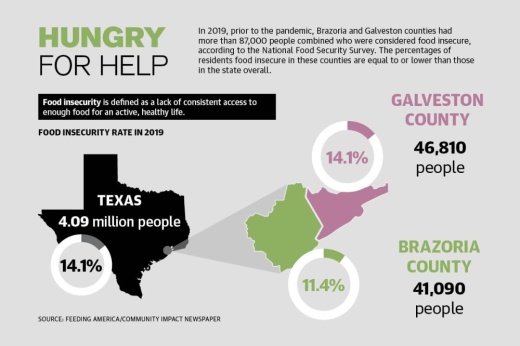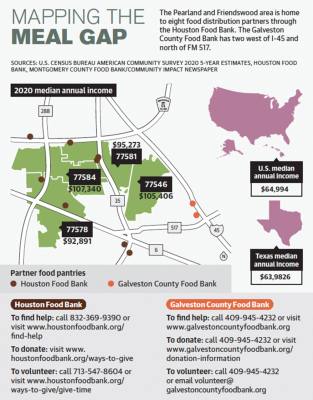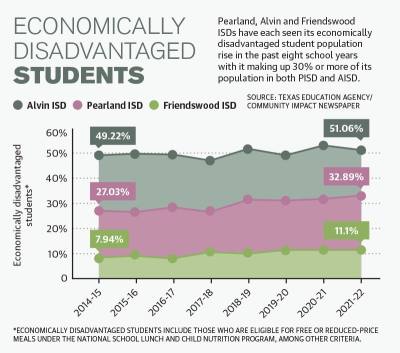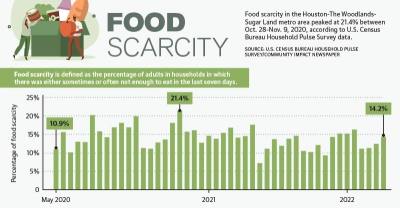According to the U.S. Census Bureau’s Household Pulse Survey, 10.9% of residents in the Houston-The Woodlands-Sugar Land metro area reported being food scarce at the start of the COVID-19 pandemic between April 23-May 5, 2020. Between Oct. 28-Nov. 9, 2020, local food scarcity peaked at 21.4% and has since fluctuated, dropping to 11.3% between March 30-April 11 this year.
Brazoria County Dream Center is seeing an uptick of families and individuals coming into their pantry in need of resources, CEO and Executive Director Terri Willis said. The Brazoria County Dream Center is a charity organization focused on helping children and adults in Brazoria County facing life challenges by providing food and other basic needs.
The organization allows those that qualify to collect food from the pantry, Willis said. People must provide identification and proof of address and income, she said.
Increasing demand
When the pandemic began, local food pantries were flooded with new clients almost overnight, said Brian Greene, president and CEO of the Houston Food Bank, which partners with the Brazoria County Dream Center.
“As soon as those closures and layoffs hit, the lines went crazy long—longer than we’ve ever seen, like, even after Hurricane Harvey,” Greene said.
Donnie VanAckeren, president and CEO of the Galveston County Food Bank, said he saw a similar increase. During one early COVID-19 distribution, he called his pastor and asked him to pray there would be enough food for each family; miraculously, there was, he said.
Willis painted a similar picture with her pantry. When the demand from families tapered off due to stimulus checks passed by the federal government in 2020 and early 2021, Brazoria County Dream Center saw a rise in seniors in need of help, she said. Then Winter Storm Uri caused another jump in demand in February 2021, she said.
The demand has begun to spike again, VanAckeren and Willis said. Both said they have seen an increase in the number of young couples relying on the food pantries for food, especially those with children.
“I am seeing that increase now, which is disconcerting for me because I have to continue to purchase more food,” Willis said. “As far as food is concerned, yes, I get food from the Houston Food Bank, but if I get a pallet of spaghetti sauce, I have to go purchase the noodles."
Brazoria County Dream Center receives about 20-25 pallets of food from the Houston Food Bank each week, Willis said. Each pallet is about 1,000 pounds of food, which, according to national nonprofit Feeding America, is roughly 833 meals, she said.
While the deliveries from the Houston Food Bank help fill out the center’s pantry, they do not provide everything it needs, she said. Brazoria County Dream Center relies on local food drives to diversify its offerings, which slowed down significantly because of the coronavirus pandemic. While the number of food drives have increased since the beginning of the pandemic, the demand for food is still greater, Willis said.
Children in need
There has been a similar increase in food scarcity among students in Pearland, Alvin and Friendswood ISDs. Since at least 2014, each district’s percentage of economically disadvantaged students—which includes those eligible for free or reduced-price meals—has increased roughly 4 percentage points at each district between 2014-22, according to Texas Education Agency data. AISD is offering a summer meal program for children this summer, director of communications Renae Rives said. PISD and FISD are not offering services this summer.
Mia Medina, program manager for No Kid Hungry Texas, said the summer is the hungriest time for Texas teens and kids. NKH Texas works with schools, local nonprofits and elected leaders across the state to help kids in need of food.
“During the school year, kids can rely on school meal programs like breakfast, lunch and after-school meals, but when school is out, many of those meals disappear,” Medina said. “That means ... their families have to stretch their budgets even further than they anticipated.”
There is a usual uptick of families in need because of children getting out of school each year during June and July, Willis said. Organizations such as NKH Texas and local food banks aim to help out those families, but even under normal circumstances, local food banks are hard pressed to meet the demand, Greene said. This year, the uptick began in May, Willis said.
“Normally, we don’t meet [the] need even on our best day because the reality of food insecurity is that food insecurity isn’t really about food; food insecurity is about income,” Greene said.
Ongoing challenges
According to the Labor Law Center, Texas is one of 20 states in the U.S. that has not raised its minimum wage over the past decade and is still at the federal minimum wage of $7.25 per hour. Meanwhile, the consumer price index for all urban consumers has risen by 8.6% in the past 12 months as of May, according to the U.S. Bureau of Labor Statistics.
Suzy Domingo, executive director of Interfaith Caring Ministries, said she sympathized with residents unable to earn enough to afford basic needs. Interfaith provides several services, including free food, to Clear Creek ISD and FISD families in need.
“There are jobs out there. They’re just not paying enough to keep up with the increase of living,” Domingo said.
Food banks, which deliver products for distribution via diesel trucks, are also dealing with their own set of challenges as prices rise, Greene said.
“We run over 60 trucks a day. We spend $3,000 plus on fuel per day, six days a week—and that was before the gas prices went up,” Greene said.
In the first quarter of 2021, the Galveston County Food Bank spent about $4,800 a month in fuel to deliver food to area food banks. This year, it has been about $9,600 a month so far, VanAckeren said.
The Houston Food Bank has provided some relief by waiving a maintenance fee it used to charge organizations it delivered food to like the Brazoria County Dream Center.
The Houston Food Bank first waived the fee in March 2020 due to the pandemic and has not charged organizations since. Willis said the Houston Food Bank will not be charging the fee for the 2023 fiscal year, which stretches from July of this year to June 2023. Brazoria County Dream Center’s monthly fee was $1,200, Willis said.
Rising food costs affect distributors as well. In April 2021, Interfaith gave about the same amount of food to residents as it did this April at a cost of $20,600. In April 2022, the cost was $27,400, Domingo said.
VanAckeren, Willis and Domingo said they have all seen donations dry up recently. While local churches and groups such as Boy Scouts have been reliable food donors in the past, they have been more scarce recently, meaning Interfaith has to spend more of its own money buying food to meet demand, Domingo said.
“We are seeing a bigger need, less donations,” Willis said.








